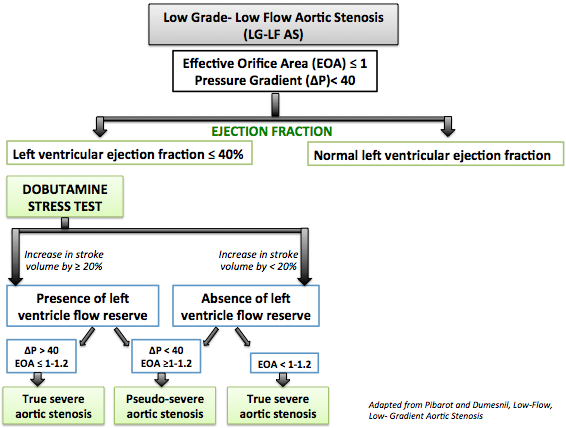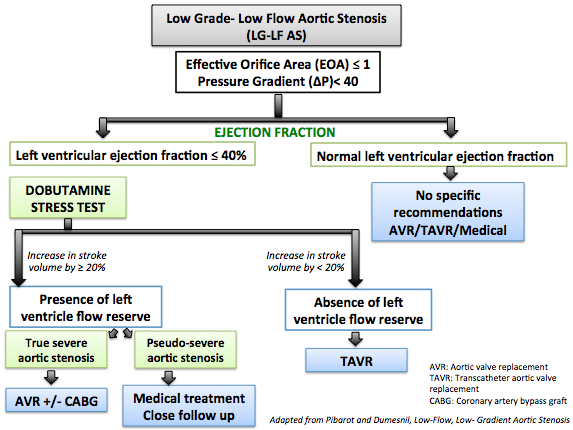Low flow, low gradient aortic stenosis
Editor-In-Chief: C. Michael Gibson, M.S., M.D. [1]; Assciate Editor-In-Chief: Rim Halaby
Synonyms and Keywords: Low flow low gradient aortic stenosis, LF-LG aortic stenosis, Low flow low gradient aortic stenosis with low ejection fraction, Low flow flow gradient aortic stenosis with normal ejection fraction
Overview
Pathophysiology
- In aortic stenosis, as the aortic orifice area decreases the transvalvular gradient increases. In fact, when the aortic valve effective orifice area decreases below 1 cm2 the mean transvalvular gradient is expected to be larger than 40 mmHg. The transvalvular gradient is highly dependant on the flow of blood through the valve.
- However, when severe systolic or/and diastolic myocardial dysfunction coexist with the aortic stenosis, there is a decrease in the flow through the valve leading to a prominent decrease in the transvalvular gradient. This is called low flow, low gradient aortic stenosis (LF-LG AS).
- LF-LG AS is a challenging diagnosis that must be done in order to tailor the management plan. It is important to recognize these entities because they might cause either underestimation or overestimation of the degree of severity of the aortic stenosis.
- Two various scenarios occur in the setting of LF-LG AS depending on the status of the left ventricular ejection fraction:
- LF-LG AS with low LVEF
- LF-LG AS with normal LVEF[1]
- Shown below is a table depicting the differences between LF-LG AS with low LVEF and LF-LG AS with normal LVEF.
| LF-LG AS | Percentage of the Cases of Severe AS Caused by LF-LG AS | Pathophysiology | Diagnostic Challenges |
| LF-LG AS with low LVEF | 5-10% of severe aortic stenosis | Decreased systolic function
-Dilated left ventricle -Decreased contractility |
Differentiation between severe aortic stenosis and pseudo-severe aortic stenosis |
| LF-LG AS with normal LVEF | 10-25% of severe aortic stenosis | Decreased diastolic function
-Small left ventricle -Decreased compliance |
Underestimation of the severity of aortic stenosis
Differentiation from confounding measurement errors and small ventricle body size |
Low Flow, Low Gradient, Low Ejection Fraction Aortic Stenosis
- When ventricular systolic dysfunction is present, the myocardium can not contract strongly enough to pump blood with a lot of pressure. In that case, low flow and subsequent low transvalvular gradient are present and this entity is called LF-LG AS with low LVEF.
- LF-LG AS with low LVEF is defined as:
- An aortic valve areas < 1.0 cm2
- A left ventricular ejection fraction < 40%
- A mean pressure difference or gradient across the aortic valve of < 30 mm Hg
- When low flow, low gradient aortic stenosis is present, the challenge is to differentiate whether the LF-LG AS with low LVEF is a true severe aortic stenosis or a pseudo-severe aortic stenosis. It is very important to differentiate between these two entities as they have different outcomes following aortic valve replacement.[1]
True severe aortic stenosis:
- The aortic stenosis is so severe that it caused secondary left ventricular dysfunction. This systolic dysfunction causes decreased contractility and hence causes decreased ejection force and low transvalvular flow and gradient.
Pseudo-severe aortic stenosis:
- The aortic stenosis is mild or moderate but it co-exists with another myocardial disease that is independent from the aortic stenosis. Overestimation of the severity of the aortic stenosis happens in this context.
- The presence of fibrosis in the left ventricle may cause an incomplete recovery after aortic valve replacement[2] .
- This scenario can also occur among patients in whom there is a history of myocardial infarction due to the absence of sufficient contractility to mount an aortic gradient.
- It may also occur when myocardial fibrosis develops due to longstanding aortic stenosis.[1]
Low Flow, Low Gradient Aortic Stenosis with Normal Ejection Fraction
- LF-LG AS with normal ejection fraction has been recently describes and it is usually an advanced stage of valvular and myocardial diseases.
- LF-LG AS with normal ejection fraction has a lot of similarities with normal ejection fraction diastolic heart failure. In fact, it is usually present in older females in the context of systemic hypertension. The underlying pathophysiology is a restrictive myocardium.
- The characteristics of LF-LG AS with normal ejection fraction is the presence of extensive remodeling due to predominant diastolic dysfunction as well as systolic dysfunction. However, the decrease in the systolic performance of the left ventricle does not show a decrease in the ejection fraction.[1]
Echocardiography
- Echocardiography is fairly accurate in the assessment of the severity of aortic stenosis in patients with normal or near normal cardiac output. However, dobutamine stress echocardiography or cardiac catheterization may be required to accurately assess the severity of aortic stenosis in patients with low output aortic stenosis.
- Low dose (<20 microgram/Kg/min) dobutamine stress echocardiography allows:
- The differentiation between severe and pseudo-severe low flow low gradient aortic stenosis through the degree of change in effective orifice area of the aortic valve after dobutamine infusion.
- The assessment of the presence or absence of left ventricular flow reserve through the degree of change in stroke volume following dobutamine infusion.
- Left ventricular flow reserve is an indicator of operative mortality. Left ventricle flow reserve does not predict recovery of left ventricle after aortic valve replacement nor the resolution of symptoms.[1]
- The aortic valve area should increase to more than 1-1.2 cm2 with a dobutamine infusion and the mean pressure gradient should rise above 30 mm Hg. While early surgical mortality is 32-33% in patients who fail to to achieve these improvements with dobutamine infusions, it is only 5–7% in patients who demonstrate an increase in their contractility and gradient. Five years survival after surgery was 88% in patients with improved contractility and only 10–25% in patients with unimproved contractility.
- Shown below is an algorithm summarizing the interpretation of the results of low dose dobutamine stress echocardiography in the evaluation of low flow, low gradient aortic stenosis.

ACC/AHA Guidelines- Recommendation [3]
| “ |
Class IIa1. Dobutamine stress echocardiography is reasonable to evaluate patients with low-flow/low-gradient aortic stenosis and left ventricular dysfunction. (Level of Evidence: B) 2. Cardiac catheterization for hemodynamic measurements with infusion of dobutamine can be useful for evaluation of patients with low-flow/low-gradient aortic stenosis and left ventricular dysfunction. (Level of Evidence: C) |
” |
Management
- Shown below is an algorithm of the management of low flow, low gradient aortic stenosis.

- ↑ 1.0 1.1 1.2 1.3 1.4 Pibarot P, Dumesnil JG (2012). "Low-flow, low-gradient aortic stenosis with normal and depressed left ventricular ejection fraction". J Am Coll Cardiol. 60 (19): 1845–53. doi:10.1016/j.jacc.2012.06.051. PMID 23062546.
- ↑ Carabello BA, Green LH, Grossman W, Cohn LH, Koster JK, Collins JJ (1980). [[]]: 42–8 http://circ.ahajournals.org/cgi/pmidlookup?view=long&pmid=7379284. Retrieved 2012-04-10. Unknown parameter
|month=ignored (help); Missing or empty|title=(help) - ↑ Bonow RO, Carabello BA, Chatterjee K, de Leon AC, Faxon DP, Freed MD; et al. (2008). "2008 focused update incorporated into the ACC/AHA 2006 guidelines for the management of patients with valvular heart disease: a report of the American College of Cardiology/American Heart Association Task Force on Practice Guidelines (Writing Committee to revise the 1998 guidelines for the management of patients with valvular heart disease). Endorsed by the Society of Cardiovascular Anesthesiologists, Society for Cardiovascular Angiography and Interventions, and Society of Thoracic Surgeons". J Am Coll Cardiol. 52 (13): e1–142. doi:10.1016/j.jacc.2008.05.007. PMID 18848134.